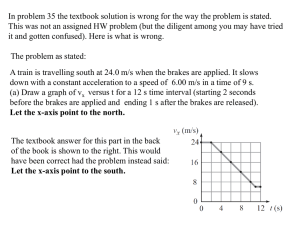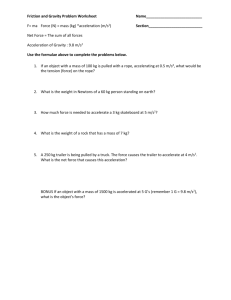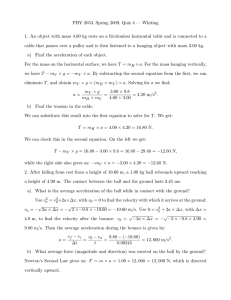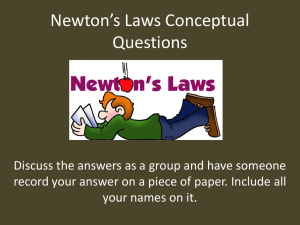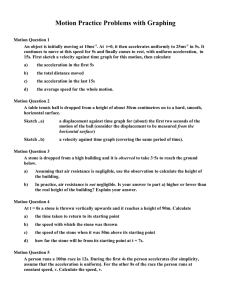77777 Instructor(s): Field/Qiu PHYSICS DEPARTMENT PHY 2053
advertisement
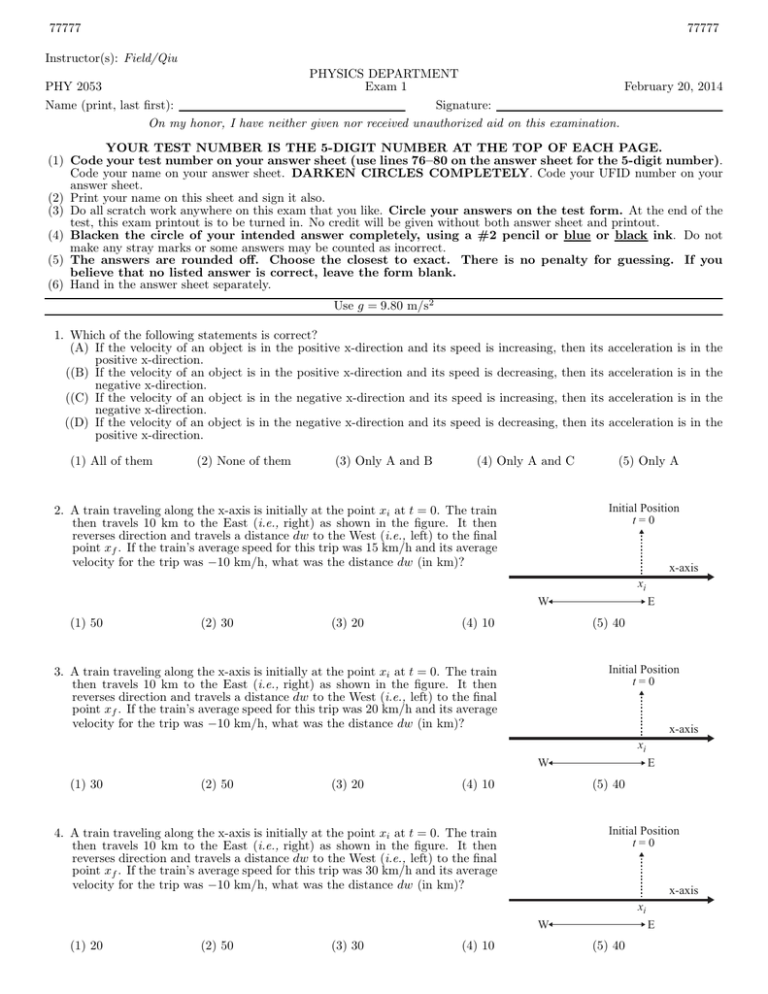
77777 77777 Instructor(s): Field/Qiu PHYSICS DEPARTMENT PHY 2053 Exam 1 February 20, 2014 Name (print, last first): Signature: On my honor, I have neither given nor received unauthorized aid on this examination. YOUR TEST NUMBER IS THE 5-DIGIT NUMBER AT THE TOP OF EACH PAGE. (1) Code your test number on your answer sheet (use lines 76–80 on the answer sheet for the 5-digit number). Code your name on your answer sheet. DARKEN CIRCLES COMPLETELY. Code your UFID number on your answer sheet. (2) Print your name on this sheet and sign it also. (3) Do all scratch work anywhere on this exam that you like. Circle your answers on the test form. At the end of the test, this exam printout is to be turned in. No credit will be given without both answer sheet and printout. (4) Blacken the circle of your intended answer completely, using a #2 pencil or blue or black ink. Do not make any stray marks or some answers may be counted as incorrect. (5) The answers are rounded off. Choose the closest to exact. There is no penalty for guessing. If you believe that no listed answer is correct, leave the form blank. (6) Hand in the answer sheet separately. Use g = 9.80 m/s2 1. Which of the following statements is correct? (A) If the velocity of an object is in the positive x-direction and its speed is increasing, then its positive x-direction. ((B) If the velocity of an object is in the positive x-direction and its speed is decreasing, then its negative x-direction. ((C) If the velocity of an object is in the negative x-direction and its speed is increasing, then its negative x-direction. ((D) If the velocity of an object is in the negative x-direction and its speed is decreasing, then its positive x-direction. (1) All of them (2) None of them (3) Only A and B (4) Only A and C acceleration is in the acceleration is in the acceleration is in the acceleration is in the (5) Only A Initial Position t=0 2. A train traveling along the x-axis is initially at the point xi at t = 0. The train then travels 10 km to the East (i.e., right) as shown in the figure. It then reverses direction and travels a distance dw to the West (i.e., left) to the final point xf . If the train’s average speed for this trip was 15 km/h and its average velocity for the trip was −10 km/h, what was the distance dw (in km)? x-axis xi W (1) 50 (2) 30 (3) 20 (4) 10 E (5) 40 Initial Position t=0 3. A train traveling along the x-axis is initially at the point xi at t = 0. The train then travels 10 km to the East (i.e., right) as shown in the figure. It then reverses direction and travels a distance dw to the West (i.e., left) to the final point xf . If the train’s average speed for this trip was 20 km/h and its average velocity for the trip was −10 km/h, what was the distance dw (in km)? x-axis xi W (1) 30 (2) 50 (3) 20 (4) 10 E (5) 40 Initial Position t=0 4. A train traveling along the x-axis is initially at the point xi at t = 0. The train then travels 10 km to the East (i.e., right) as shown in the figure. It then reverses direction and travels a distance dw to the West (i.e., left) to the final point xf . If the train’s average speed for this trip was 30 km/h and its average velocity for the trip was −10 km/h, what was the distance dw (in km)? x-axis xi W (1) 20 (2) 50 (3) 30 (4) 10 E (5) 40 77777 77777 5. A motorist drives along a straight road at a constant speed of 80 m/s. Just as she passes a parked motorcycle police officer, the officer takes off after her at a constant acceleration, a, and at that same instant the motorist begins to accelerate at a constant rate of a/5 (i.e., one-fifth the acceleration of the police officer). If the driver and the officer maintain their constant value of acceleration, what is the speed of the police officer when he reaches the motorist (in m/s)? (1) 200 (2) 240 (3) 320 (4) 160 (5) 400 6. A motorist drives along a straight road at a constant speed of 80 m/s. Just as she passes a parked motorcycle police officer, the officer takes off after her at a constant acceleration, a, and at that same instant the motorist begins to accelerate at a constant rate of a/3 (i.e., one-third the acceleration of the police officer). If the driver and the officer maintain their constant value of acceleration, what is the speed of the police officer when he reaches the motorist (in m/s)? (1) 240 (2) 200 (3) 320 (4) 160 (5) 400 7. A motorist drives along a straight road at a constant speed of 80 m/s. Just as she passes a parked motorcycle police officer, the officer takes off after her at a constant acceleration, a, and at that same instant the motorist begins to accelerate at a constant rate of a/2 (i.e., one-half the acceleration of the police officer). If the driver and the officer maintain their constant value of acceleration, what is the speed of the police officer when he reaches the motorist (in m/s)? (1) 320 (2) 200 (3) 240 (4) 160 (5) 400 8. Near the surface of the Earth, a suspension bridge is a height H above the level base of a gorge. A stone is thrown straight down with a speed of 10 m/s. Ignore air resistance. If it takes the stone 2 seconds to reach the bottom of the gorge, what is the height H of the bridge (in m)? (1) 39.6 (2) 43.6 (3) 49.6 (4) 19.6 (5) 12.7 9. Near the surface of the Earth, a suspension bridge is a height H above the level base of a gorge. A stone is thrown straight down with a speed of 12 m/s. Ignore air resistance. If it takes the stone 2 seconds to reach the bottom of the gorge, what is the height H of the bridge (in m)? (1) 43.6 (2) 39.6 (3) 49.6 (4) 19.6 (5) 12.7 10. Near the surface of the Earth, a suspension bridge is a height H above the level base of a gorge. A stone is thrown straight down with a speed of 15 m/s. Ignore air resistance. If it takes the stone 2 seconds to reach the bottom of the gorge, what is the height H of the bridge (in m)? (1) 49.6 (2) 39.6 (3) 43.6 (4) 19.6 11. If the x-component of the vector shown in the figure is 10 and the angle it makes with the x-axis θ = 50◦ , what is its magnitude (i.e., length)? (5) 12.7 y-axis θ (1) 15.6 (2) 20.0 (3) 29.2 (4) 10.0 12. If the x-component of the vector shown in the figure is 10 and the angle it makes with the x-axis θ = 60◦ , what is its magnitude (i.e., length)? (5) 35.6 y-axis θ (1) 20.0 (2) 15.6 (3) 29.2 (4) 10.0 x-axis x-axis (5) 35.6 77777 77777 13. If the x-component of the vector shown in the figure is 10 and the angle it makes with the x-axis θ = 70◦ , what is its magnitude (i.e., length)? y-axis θ (1) 29.2 (2) 15.6 (3) 20.0 (4) 10.0 x-axis (5) 35.6 14. Near the surface of the Earth, two blocks (A and B) are at rest on a table as shown in the figure. If MA = 1 kg and the magnitude of the normal force exerted by the table on block B is 29.4 N, what is the mass of block B (in kg)? (1) 2 (2) 3 (3) 4 A B (4) 5 (5) 1 15. Near the surface of the Earth, two blocks (A and B) are at rest on a table as shown in the figure. If MA = 1 kg and the magnitude of the normal force exerted by the table on block B is 39.2 N, what is the mass of block B (in kg)? (1) 3 (2) 2 (3) 4 A B (4) 5 (5) 1 16. Near the surface of the Earth, two blocks (A and B) are at rest on a table as shown in the figure. If MA = 1 kg and the magnitude of the normal force exerted by the table on block B is 49.0 N, what is the mass of block B (in kg)? (1) 4 (2) 2 (3) 3 (4) 5 17. Near the surface of the Earth, two blocks of mass M1 and M2 are held at rest on a frictionless plane inclined at an angle θ by a rope attached to the wall, as shown in the figure. The tension in the rope that attaches block 1 to the wall is T1 , and the tension in the rope that attaches block 2 to block 1 is T2 . If T1 is three times T2 (i.e., . T1 = 3T2 ), then what is the mass M2 ? (1) 1 M1 2 (2) 1 M1 3 (3) 1 M1 4 1 M1 3 (2) 1 M1 2 (3) 1 M1 4 (5) 1 T1 T2 (4) M1 M1 M2 θ (4) M1 18. Near the surface of the Earth, two blocks of mass M1 and M2 are held at rest on a frictionless plane inclined at an angle θ by a rope attached to the wall, as shown in the figure. The tension in the rope that attaches block 1 to the wall is T1 , and the tension in the rope that attaches block 2 to block 1 is T2 . If T1 is four times T2 (i.e., . T1 = 4T2 ), then what is the mass M2 ? (1) A B (5) 2M1 T1 T2 M1 M2 θ (5) 2M1 77777 77777 19. Near the surface of the Earth, two blocks of mass M1 and M2 are held at rest on a frictionless plane inclined at an angle θ by a rope attached to the wall, as shown in the figure. The tension in the rope that attaches block 1 to the wall is T1 , and the tension in the rope that attaches block 2 to block 1 is T2 . If T1 is five times T2 (i.e., . T1 = 5T2 ), then what is the mass M2 ? T1 T2 M1 M2 θ (1) 1 M1 4 (2) 1 M1 2 (3) 1 M1 3 (4) M1 (5) 2M1 20. In the figure, blocks A and C have a mass of 30 kg and 10 kg, respectively. If the surface of the table is frictionless and the static coefficient of friction, µs , between block A and block C is 0.20, what is the maximum mass of block B (in kg) such that, when the system is released from rest, block C will not slip off block A? Frictionless, massless pulley C A B (1) 10 (2) 40 (3) 60 (4) 30 (5) 5 21. In the figure, blocks A and C have a mass of 30 kg and 10 kg, respectively. If the surface of the table is frictionless and the static coefficient of friction, µs , between block A and block C is 0.50, what is the maximum mass of block B (in kg) such that, when the system is released from rest, block C will not slip off block A? Frictionless, massless pulley C A B (1) 40 (2) 10 (3) 60 (4) 30 (5) 5 22. In the figure, blocks A and C have a mass of 30 kg and 10 kg, respectively. If the surface of the table is frictionless and the static coefficient of friction, µs , between block A and block C is 0.60, what is the maximum mass of block B (in kg) such that, when the system is released from rest, block C will not slip off block A? Frictionless, massless pulley C A B (1) 60 (2) 10 (3) 40 (4) 30 23. Two point masses, M1 and M2 , lie on the x-axis a distance 2d apart. A third point mass, M3 , lies on the x-axis a distance d from M1 and a distance d from M2 as shown in the figure. If M1 = M , M2 = 2M , and M3 = M , what is the magnitude of the net gravitational force on M3 due to the other two masses? (1) GM 2 /d2 (2) 2GM 2 /d2 (3) 3GM 2 /d2 (2) GM 2 /d2 (3) 3GM 2 /d2 M1 M3 d x-axis (5) zero M1 (4) 4GM 2 /d2 M2 d (4) 4GM 2 /d2 24. Two point masses, M1 and M2 , lie on the x-axis a distance 2d apart. A third point mass, M3 , lies on the x-axis a distance d from M1 and a distance d from M2 as shown in the figure. If M1 = M , M2 = 3M , and M3 = M , what is the magnitude of the net gravitational force on M3 due to the other two masses? (1) 2GM 2 /d2 (5) 5 M3 d M2 d (5) zero x-axis 77777 77777 25. Two point masses, M1 and M2 , lie on the x-axis a distance 2d apart. A third point mass, M3 , lies on the x-axis a distance d from M1 and a distance d from M2 as shown in the figure. If M1 = M , M2 = 4M , and M3 = M , what is the magnitude of the net gravitational force on M3 due to the other two masses? (1) 3GM 2 /d2 (2) GM 2 /d2 (3) 2GM 2 /d2 M1 M3 d d (4) 4GM 2 /d2 26. Near the surface of the Earth a ball of mass M is attached to a thin rope with negligible mass and length L = 2.5 m. The ball and rope are attached to a vertical pole and the entire apparatus, including the pole, rotates with a constant angular velocity about the pole’s symmetry axis, as shown in the figure. If it takes the ball 1.8 seconds to make one complete revolution, what is the angle θ? M2 x-axis (5) zero θ L axis of rotation (1) 71.2◦ (2) 61.3◦ (3) 51.6◦ (4) 82.5◦ 27. Near the surface of the Earth a ball of mass M is attached to a thin rope with negligible mass and length L = 2.5 m. The ball and rope are attached to a vertical pole and the entire apparatus, including the pole, rotates with a constant angular velocity about the pole’s symmetry axis, as shown in the figure. If it takes the ball 2.2 seconds to make one complete revolution, what is the angle θ? (5) 46.2◦ θ L axis of rotation (1) 61.3◦ (2) 71.2◦ (3) 51.6◦ (4) 82.5◦ 28. Near the surface of the Earth a ball of mass M is attached to a thin rope with negligible mass and length L = 2.5 m. The ball and rope are attached to a vertical pole and the entire apparatus, including the pole, rotates with a constant angular velocity about the pole’s symmetry axis, as shown in the figure. If it takes the ball 2.5 seconds to make one complete revolution, what is the angle θ? (5) 46.2◦ θ L axis of rotation (1) 51.6 ◦ (2) 71.2 ◦ (3) 61.3 ◦ (4) 82.5 ◦ (5) 46.2◦ 29. A spacecraft is in a circular orbit around a spherical planet. The radius of the orbit is three times the radius of the planet and the period of the spacecraft’s orbit is 14 hours. If the acceleration due to gravity at the surface of the planet is 25 m/s2 , what is the radius of the planet (in km)? (1) 59,577 (2) 68,392 (3) 77,815 (4) 45,202 (5) 85,678 30. A spacecraft is in a circular orbit around a spherical planet. The radius of the orbit is three times the radius of the planet and the period of the spacecraft’s orbit is 15 hours. If the acceleration due to gravity at the surface of the planet is 25 m/s2 , what is the radius of the planet (in km)? (1) 68,392 (2) 59,577 (3) 77,815 (4) 45,202 (5) 85,678 31. A spacecraft is in a circular orbit around a spherical planet. The radius of the orbit is three times the radius of the planet and the period of the spacecraft’s orbit is 16 hours. If the acceleration due to gravity at the surface of the planet is 25 m/s2 , what is the radius of the planet (in km)? (1) 77,815 (2) 59,577 (3) 68,392 (4) 45,202 (5) 85,678 77777 77777 ω 32. Near ther surface of the Earth, a carnival ride consists of the riders standing against the inside wall of a cylindrical room with radius R = 5.0 m. The room spins about the vertical cylinder axis with angular velocity ω, as shown in the figure. Once it is up to speed, the floor of the room falls away. If the minimum angular velocity ω that will keep them from dropping with the floor is 2.0 rad/s, what is the coefficient of static friction, µs , between the riders and the wall? (1) 0.490 (2) 0.314 (3) 0.218 r (4) 0.186 (5) 0.543 ω 33. Near ther surface of the Earth, a carnival ride consists of the riders standing against the inside wall of a cylindrical room with radius R = 5.0 m. The room spins about the vertical cylinder axis with angular velocity ω, as shown in the figure. Once it is up to speed, the floor of the room falls away. If the minimum angular velocity ω that will keep them from dropping with the floor is 2.5 rad/s, what is the coefficient of static friction, µs , between the riders and the wall? (1) 0.314 (2) 0.490 (3) 0.218 r (4) 0.186 (5) 0.543 ω 34. Near ther surface of the Earth, a carnival ride consists of the riders standing against the inside wall of a cylindrical room with radius R = 5.0 m. The room spins about the vertical cylinder axis with angular velocity ω, as shown in the figure. Once it is up to speed, the floor of the room falls away. If the minimum angular velocity ω that will keep them from dropping with the floor is 3.0 rad/s, what is the coefficient of static friction, µs , between the riders and the wall? (1) 0.218 (2) 0.490 (3) 0.314 r (4) 0.186 (5) 0.543 35. A stone of mass m is released from rest a height h = RE above the surface of the Earth, where RE is the radius of the Earth. What is the speed of the stone (in km/s) when it hits the Earth? Ignore air resistance and take RE = 6.371×106m, ME = 5.974 × 1024kg, and G = 6.674 × 10−11N·m2 /kg2 , where ME is the mass of the Earth and G is Newton’s constant. (1) 7.91 (2) 8.67 (3) 9.13 (4) 11.19 (5) 13.70 36. A stone of mass m is released from rest a height h = 1.5RE above the surface of the Earth, where RE is the radius of the Earth. What is the speed of the stone (in km/s) when it hits the Earth? Ignore air resistance and take RE = 6.371×106m, ME = 5.974 × 1024kg, and G = 6.674 × 10−11N·m2 /kg2 , where ME is the mass of the Earth and G is Newton’s constant. (1) 8.67 (2) 7.91 (3) 9.13 (4) 11.19 (5) 13.70 37. A stone of mass m is released from rest a height h = 2RE above the surface of the Earth, where RE is the radius of the Earth. What is the speed of the stone (in km/s) when it hits the Earth? Ignore air resistance and take RE = 6.371×106m, ME = 5.974 × 1024kg, and G = 6.674 × 10−11N·m2 /kg2 , where ME is the mass of the Earth and G is Newton’s constant. (1) 9.13 (2) 7.91 (3) 8.67 (4) 15.82 38. Near the surface of the Earth a block of mass M starts from rest at a height H = 10 m above a level surface and slides down a smooth frictionless ramp as shown in the figure. The block slides down the ramp and across the level surface. All the surfaces are frictionless except the region between x = 0 and x = d, where the kinetic coefficient of friction µk is 0.75. If d = 6 m, what is the speed of the block (in m/s) when it reaches the point x = d? (1) 10.38 (2) 8.85 (3) 7.00 (4) 4.43 (5) 13.70 M d H x=0 (5) 14.00 x=d x-axis 77777 77777 39. Near the surface of the Earth a block of mass M starts from rest at a height H = 10 m above a level surface and slides down a smooth frictionless ramp as shown in the figure. The block slides down the ramp and across the level surface. All the surfaces are frictionless except the region between x = 0 and x = d, where the kinetic coefficient of friction µk is 0.75. If d = 8 m, what is the speed of the block (in m/s) when it reaches the point x = d? (1) 8.85 (2) 10.38 (3) 7.00 (2) 10.38 (3) 8.85 x=0 (2) 4 (3) 8 (2) 3 (3) 8 (2) 3 (3) 4 x=d x-axis d H x=0 (4) 4.43 (5) 14.00 y-axis O-frame x-axis (5) 2 y-axis O-frame V O’-frame x-axis (4) 5 (5) 2 y-axis O-frame V O’-frame x-axis (4) 5 44. A ball is thrown with an initial speed v0 = 20 m/s from a dorm room window a height H above the level ground at an angle θ with the horizontal as shown in the figure. At that same instant a man begins running from the base of the building at a constant speed V = 10 m/s? What positive angle θ must the ball be thrown such that it will hit the man? Ignore air resistance. V O’-frame (4) 5 43. A train (O’-frame) is moving down the x-axis of the O-frame at speed V as shown in the figure. An observer at rest in the O’-frame throws a stone straight up with speed vy′ = 6 m/s (as observed in the O’-frame). If the speed of the stone as observed by an observer at rest in the O-frame is 10 m/s, what is the speed V of the train (in m/s)? (1) 8 x-axis M 42. A train (O’-frame) is moving down the x-axis of the O-frame at speed V as shown in the figure. An observer at rest in the O’-frame throws a stone straight up with speed vy′ = 3 m/s (as observed in the O’-frame). If the speed of the stone as observed by an observer at rest in the O-frame is 5 m/s, what is the speed V of the train (in m/s)? (1) 4 x=d (5) 14.00 41. A train (O’-frame) is moving down the x-axis of the O-frame at speed V as shown in the figure. An observer at rest in the O’-frame throws a stone straight up with speed vy′ = 4 m/s (as observed in the O’-frame). If the speed of the stone as observed by an observer at rest in the O-frame is 5 m/s, what is the speed V of the train (in m/s)? (1) 3 d H (4) 4.43 40. Near the surface of the Earth a block of mass M starts from rest at a height H = 10 m above a level surface and slides down a smooth frictionless ramp as shown in the figure. The block slides down the ramp and across the level surface. All the surfaces are frictionless except the region between x = 0 and x = d, where the kinetic coefficient of friction µk is 0.75. If d = 10 m, what is the speed of the block (in m/s) when it reaches the point x = d? (1) 7.00 M (5) 2 v0 θ H Dorm V ground (1) 60.0◦ (2) 75.5◦ (3) 41.4◦ (4) 64.3◦ (5) 30.0◦ 77777 77777 v0 45. A ball is thrown with an initial speed v0 = 20 m/s from a dorm room window a height H above the level ground at an angle θ with the horizontal as shown in the figure. At that same instant a man begins running from the base of the building at a constant speed V = 5 m/s? What positive angle θ must the ball be thrown such that it will hit the man? Ignore air resistance. θ H Dorm V ground (1) 75.5 ◦ (2) 60.0 ◦ (3) 41.4 ◦ (4) 64.3 ◦ (5) 30.0◦ v0 46. A ball is thrown with an initial speed v0 = 20 m/s from a dorm room window a height H above the level ground at an angle θ with the horizontal as shown in the figure. At that same instant a man begins running from the base of the building at a constant speed V = 15 m/s? What positive angle θ must the ball be thrown such that it will hit the man? Ignore air resistance. θ H Dorm V ground (1) 41.4 ◦ (2) 60.0 ◦ (3) 75.5 ◦ (4) 64.3 47. Near the surface of the Earth, a ball is thrown with an initial speed v0 horizontally from a dorm room window a height of H = 10 meters above the level ground. The ball hits a horizontal wall a height h = 2 meters above the ground as shown in the figure. If the wall is a horizontal distance d = 6 meters from the dorm, what is the initial speed v0 of the ball (in m/s)? Ignore air resistance. ◦ (5) 30.0◦ H v0 Wall Dorm d h ground (1) 4.7 (2) 5.5 (3) 6.3 (4) 3.2 48. Near the surface of the Earth, a ball is thrown with an initial speed v0 horizontally from a dorm room window a height of H = 10 meters above the level ground. The ball hits a horizontal wall a height h = 2 meters above the ground as shown in the figure. If the wall is a horizontal distance d = 7 meters from the dorm, what is the initial speed v0 of the ball (in m/s)? Ignore air resistance. (5) 8.1 H v0 Wall Dorm d h ground (1) 5.5 (2) 4.7 (3) 6.3 (4) 3.2 49. Near the surface of the Earth, a ball is thrown with an initial speed v0 horizontally from a dorm room window a height of H = 10 meters above the level ground. The ball hits a horizontal wall a height h = 2 meters above the ground as shown in the figure. If the wall is a horizontal distance d = 8 meters from the dorm, what is the initial speed v0 of the ball (in m/s)? Ignore air resistance. (5) 8.1 H v0 Wall Dorm d ground (1) 6.3 (2) 4.7 (3) 5.5 (4) 3.2 (5) 8.1 h 77777 77777 50. An ideal spring with spring constant k is on a frictionless horizontal surface at the base of a frictionless inclined plane with height H as shown in the figure. A block with mass M is pressed against the spring, compressing it 2 cm from its equilibrium position. The block is then released and is not attached to the spring. If the block slides one-fourth the way up the inclined plane before coming to rest and then sliding back down, what minimum additional distance (in cm) must the spring be compressed so that the block will make it to the top of the incline plane? (1) 2 (2) 4 (3) 1 (2) 2 (3) 1 (2) 2 (3) 4 (4) 3 θ H (5) 5 k M (4) 3 52. An ideal spring with spring constant k is on a frictionless horizontal surface at the base of a frictionless inclined plane with height H as shown in the figure. A block with mass M is pressed against the spring, compressing it 2 cm from its equilibrium position. The block is then released and is not attached to the spring. If the block slides four-ninths the way up the inclined plane before coming to rest and then sliding back down, what minimum additional distance (in cm) must the spring be compressed so that the block will make it to the top of the incline plane? (1) 1 M (4) 3 51. An ideal spring with spring constant k is on a frictionless horizontal surface at the base of a frictionless inclined plane with height H as shown in the figure. A block with mass M is pressed against the spring, compressing it 2 cm from its equilibrium position. The block is then released and is not attached to the spring. If the block slides one-ninth the way up the inclined plane before coming to rest and then sliding back down, what minimum additional distance (in cm) must the spring be compressed so that the block will make it to the top of the incline plane? (1) 4 k θ H (5) 5 k M θ H (5) 5 53. A race car starts from rest at t = 0 and travels around a circular track of radius R with a constant angular acceleration. If the race car completes its first revolution around the track in 1 minute, at what time t (in s) is the magnitude of the tangential acceleration of the car equal to the magnitude of the radial acceleration (i.e., centripetal acceleration) of the car? (1) 16.9 (2) 33.9 (3) 50.8 (4) 12.1 (5) 8.2 54. A race car starts from rest at t = 0 and travels around a circular track of radius R with a constant angular acceleration. If the race car completes its first revolution around the track in 2 minutes, at what time t (in s) is the magnitude of the tangential acceleration of the car equal to the magnitude of the radial acceleration (i.e., centripetal acceleration) of the car? (1) 33.9 (2) 16.9 (3) 50.8 (4) 12.1 (5) 8.2 55. A race car starts from rest at t = 0 and travels around a circular track of radius R with a constant angular acceleration. If the race car completes its first revolution around the track in 3 minutes, at what time t (in s) is the magnitude of the tangential acceleration of the car equal to the magnitude of the radial acceleration (i.e., centripetal acceleration) of the car? (1) 50.8 (2) 16.9 (3) 33.9 (4) 12.1 (5) 8.2 56. Ice fishing equipment weighing 2,000 N is pulled at a constant speed V = 0.5 m/s across a frozen lake by means of a horizontal rope. If the coefficient of kinetic friction is 0.04, what is the work done (in J) by the fisherman in pulling the equipment a distance of 500 m? (1) 4.0 × 104 (2) 5.0 × 104 (3) 6.0 × 104 (4) 3.0 × 104 (5) 2.0 × 104 77777 77777 57. Ice fishing equipment weighing 2,000 N is pulled at a constant speed V = 0.5 m/s across a frozen lake by means of a horizontal rope. If the coefficient of kinetic friction is 0.05, what is the work done (in J) by the fisherman in pulling the equipment a distance of 500 m? (1) 5.0 × 104 (2) 4.0 × 104 (3) 6.0 × 104 (4) 3.0 × 104 (5) 2.0 × 104 58. Ice fishing equipment weighing 2,000 N is pulled at a constant speed V = 0.5 m/s across a frozen lake by means of a horizontal rope. If the coefficient of kinetic friction is 0.06, what is the work done (in J) by the fisherman in pulling the equipment a distance of 500 m? (1) 6.0 × 104 (2) 4.0 × 104 (3) 5.0 × 104 (4) 3.0 × 104 (5) 2.0 × 104 FOLLOWING GROUPS OF QUESTIONS WILL BE SELECTED AS ONE GROUP FROM EACH TYPE TYPE 1 Q# S 2 Q# S 3 Q# S 4 TYPE 2 Q# S 5 Q# S 6 Q# S 7 TYPE 3 Q# S 8 Q# S 9 Q# S 10 TYPE 4 Q# S 11 Q# S 12 Q# S 13 TYPE 5 Q# S 14 Q# S 15 Q# S 16 TYPE 6 Q# S 17 Q# S 18 Q# S 19 TYPE 7 Q# S 20 Q# S 21 Q# S 22 TYPE 8 Q# S 23 Q# S 24 Q# S 25 TYPE 9 Q# S 26 Q# S 27 Q# S 28 TYPE 10 Q# S 29 Q# S 30 Q# S 31 TYPE 11 Q# S 32 Q# S 33 Q# S 34 TYPE 12 Q# S 35 Q# S 36 Q# S 37 TYPE 13 Q# S 38 Q# S 39 Q# S 40 TYPE 14 Q# S 41 77777 Q# S 42 Q# S 43 TYPE 15 Q# S 44 Q# S 45 Q# S 46 TYPE 16 Q# S 47 Q# S 48 Q# S 49 TYPE 17 Q# S 50 Q# S 51 Q# S 52 TYPE 18 Q# S 53 Q# S 54 Q# S 55 TYPE 19 Q# S 56 Q# S 57 Q# S 58 77777

